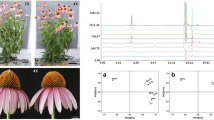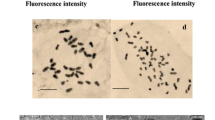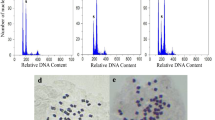Abstract
The impact of the ploidy level on biomass accumulation and the production of high-value secondary metabolites was studied in Echinacea purpurea (L.) Moench. Tetraploid E. purpurea was obtained by treating diploid explants with colchicine. The morphology, biomass yield, the contents of caffeic acid derivatives and alkamides, and the activities of phenylalanine ammonia-lyase (PAL) and cinnamate 4-hydroxylase (C4H) were compared between diploid plants and tetraploid plants of E. purpurea. The total fresh root weight and total dry root weight of the tetraploid plants were 39.32 and 40.48 % higher than those of the diploid plants, respectively. The chemical profiles of the diploid and tetraploid E. purpurea plants were similar, as determined through a comparison of their FTIR spectra and second derivative spectra. The caffeic acid derivatives and alkamides in the diploid and tetraploid plants were determined by HPLC. The tetraploid plants had higher contents of both of these types of molecules. In addition, the tetraploid plants had higher PAL and C4H activities compared with the diploid plants. The enhancement in the PAL and C4H activities was accompanied with an increase in the cichoric acid content, which indicates that the induction of polyploidy in E. purpurea resulted in higher PAL and C4H expression and promoted the biosynthesis of cichoric acid. Therefore, the induction of polyploidy may be a valid strategy to achieve a higher yield of biomass and bioactive compounds in E. purpurea.








Similar content being viewed by others
References
Abashi BH, Stiles AR, Saxena PK, Liu CZ (2012) Gibberellic acid increases secondary metabolite production in Echinacea purpurea hairy roots. Appl Biochem Biotechnol 168:2057–2066
Adams K, Wendel J (2005) Polyploidy and genome evolution in plants. Curr Opin Plant Biol 8:135–141
Adams K, Precifield R, Wendel J (2004) Organ-specific silencing of duplicated genes in a newly synthesized cotton allotetraploid. Genetics 168:2217–2226
Barnes J, Anderson LA, Gibbons S, Phillipson JD (2005) Echinacea species (Echinacea Angustifolia (DC.) Hell., Echinacea pallida (Nutt.) Nutt., Echinacea purpurea (L.) Moench): a review of their chemistry, pharmacology and clinical properties. J Pharm Pharmcol 57:929–954
Barrett B (2003) Medicinal properties of Echinacea: a critical review. Phytomedicine 10:66–86
Bate NJ, Orr J, Ni W, Meroni A, Nadler-Hassar T, Doerner PW, Dixon RA, Lamb CJ, Elkind Y (1994) Quantitative relationship between phenylalanine ammonia-lyase levels and phenylpropanoid accumulation in transgenic tobacco identifies a rate determining step in natural product synthesis. Proc Natl Acad Sci USA 91:7608–7612
Berkov S, Philipov S (2002) Alkaloid production in diploid and autotetraploid plants of Mature stramonium. Pharm Biol 40:617–621
Bi HH, Zeng RS, Su LM, An M, Luo SM (2007) Rice allelopathy induced by methyl jasmonate and methyl salicylate. J Chem Ecol 33:1089–1103
Buggs RJA, Doust AN, Tate JA, Kon J, Soltis K, Feltus FA, Paterson AH, Soltis PS, Soltis DE (2009) Gene loss and silencing in Tragopogon miscellus (Asteraceae): comparison of natural and synthetic allotetraploids. Heredity 103:73–81
Caruso I, Lepore L, De Tommasi N, Piaz FD, Frusciante L, Aversano R, Garramone R, Carputo D (2011) Secondary metabolite profile in induced tetraploids of wild Solanum commersonii Dun. Chem Biodivers 8:2226–2237
Chen ZJ, Ni ZF (2006) Mechanisms of genomic rearrangements and gene expression changes in plant polyploids. BioEssays 28:240–252
Comai L (2000) Genetic and epigenetic interactions in allopolyploid plants. Plant Mol Biol 43:387–399
Dehghan E, Hakkinen S, Oksman-Caldentey KM, Ahmadi FS (2012) Production of tropane alkaloids in diploid and tetraploid plants and in vitro hairy root cultures of Egyptian henbane (Hyoscyamus muticus L.). Plant Cell Tissue Organ Cult 110:35–44
Dhawan OP, Lavania UC (1996) Enhancing the productivity of secondary metabolites via induced polyploidy: a review. Euphytica 87:81–89
Dixon R, Pavia N (1995) Stress-induced phenylpropanoid metabolism. Plant Cell 7:1085–1097
Edwars R, Kessmann H (1992) Isoflavonoid phytoalexins and their biosynthetic enzymes. In: Gurr SJ, McPherson MJ, Bowles DJ (eds) Molecular plant pathology: a practical approach. IRL Press, Oxford, pp 45–62
Gao SL, Zhu DN, Cai ZH, Xu DR (1996) Autotetraploid plants from colchicine treated bud culture of Salvia miltiorrhiza Bge. Plant Cell Tissue Organ Cult 47:73–77
Hahlbrock K, Scheel D (1989) Physiology and molecular biology of phenylpropanoid metabolism. Annu Rev Plant Physiol Plant Mol Biol 40:347–369
Hall C III (2003) Echinacea as a functional food ingredient. Adv Food Nutr Res 47:113–173
Hegarty MJ, Hiscock SJ (2008) Genomic clues to the evolutionary success of review polyploid plants. Curr Biol 18:4352–4441
Kaensaksiri T, Soontornchainaksaeng P, Soonthornchareonnon N, Prathanturarug S (2011) In vitro induction of polyploidy in Centella asiatica (L.) Urban. Plant Cell Tissue Organ Cult 107:187–194
Kashkush K, Feldman M, Levy A (2002) Gene loss, silencing and activation in a newly synthesized wheat allotetraploid. Genetics 160:1651–1659
Lamb C, Rubery PH (1975) A spectrophotometric assay for trans-cinnamic acid 4-hydroxylase activity. Anal Biochem 68:554–561
Lavania UC (2005) Genomic and ploidy manipulation for enhanced production of phyto-pharmaceuticals. Plant Genet Resour 3:170–177
Lavania UC, Srivastava S, Lavania S, Basu S, Misra NK, Mukai Y (2012) Autopolyploidy differentially influences body size in plants, but facilitates enhanced accumulation of secondary metabolites, causing increased cytosine methylation. Plant J 71:539–549
Leitch AR, Leitch IJ (2008) Genomic plasticity and the diversity of polyploid plants. Science 320(25):481–483
Lindenmuth GF, Lindenmuth EB (2000) The efficacy of Echinacea compound herbal tea preparation on the severity and duration of upper respiratory and flu symptoms: a randomized, double-blind placebo-controlled study. J Altern Complement Med 6:327–334
Luo XB, Chen B, Yao SZ, Zeng JG (2003) Simultaneous analysis of caffeic acid derivatives and alkamides in roots and extracts of Echinacea purpurea by high-performance liquid chromatography–photodiode array detection-electrospray mass spectrometry. J Chromatogr A 986:73–81
Nilanthi D, Chen XL, Zhao FC, Yang YS, Wu H (2009) Induction of tetraploids from petiole explants through colchicine treatments in Echinacea purpurea L. J Biomed Biotech. doi:10.1155//343485
Pina A, Zhebentyayeva T, Errea P (2012) Isolation and molecular characterization of cinnamate 4-hydroxylase from apricot and plum. Biol Plant 56(3):441–450
Schilmiller AL, Stout J, Weng JK, Humphreys J, Ruegger MO, Chapple C (2009) Mutations in the cinnamate 4-hydroxylase gene impact metabolism, growth and development in Arabidopsis. Plant J 60:771–782
Sun Q, Sun H, Bell RL, Li H, Xin L (2011) Variation of phenotype, ploidy level, and organogenic potential of in vitro regenerated polyploids of Pyrus communis. Plant Cell Tissue Organ Cult 107:131–140
Van Laere K, Franca SC, Vansteenkiste H, Van Huylenbroeck J, Steppe K, Van Labeke MC (2011) Influence of ploidy level on morphology, growth and drought susceptibility in Spathiphyllum wallisii. Acta Physiol Plant 33:1149–1156
Wendel J (2000) Genome evolution in polyploids. Plant Mol Biol 42:225–249
Acknowledgements
This research study was funded by grants from a special program for Enterprise, University, and Research Institute Cooperation of Guangdong Province and the Ministry of Education of China (No. 2008B090500250) and from the Science and Technology Planning Project of Guangdong Province, China (No. 2011B031700026).
Author information
Authors and Affiliations
Corresponding author
Additional information
Chuan-gui Xu and Tie-xin Tang are co-first authors.
Rights and permissions
About this article
Cite this article
Xu, Cg., Tang, Tx., Chen, R. et al. A comparative study of bioactive secondary metabolite production in diploid and tetraploid Echinacea purpurea (L.) Moench. Plant Cell Tiss Organ Cult 116, 323–332 (2014). https://doi.org/10.1007/s11240-013-0406-z
Received:
Accepted:
Published:
Issue Date:
DOI: https://doi.org/10.1007/s11240-013-0406-z




